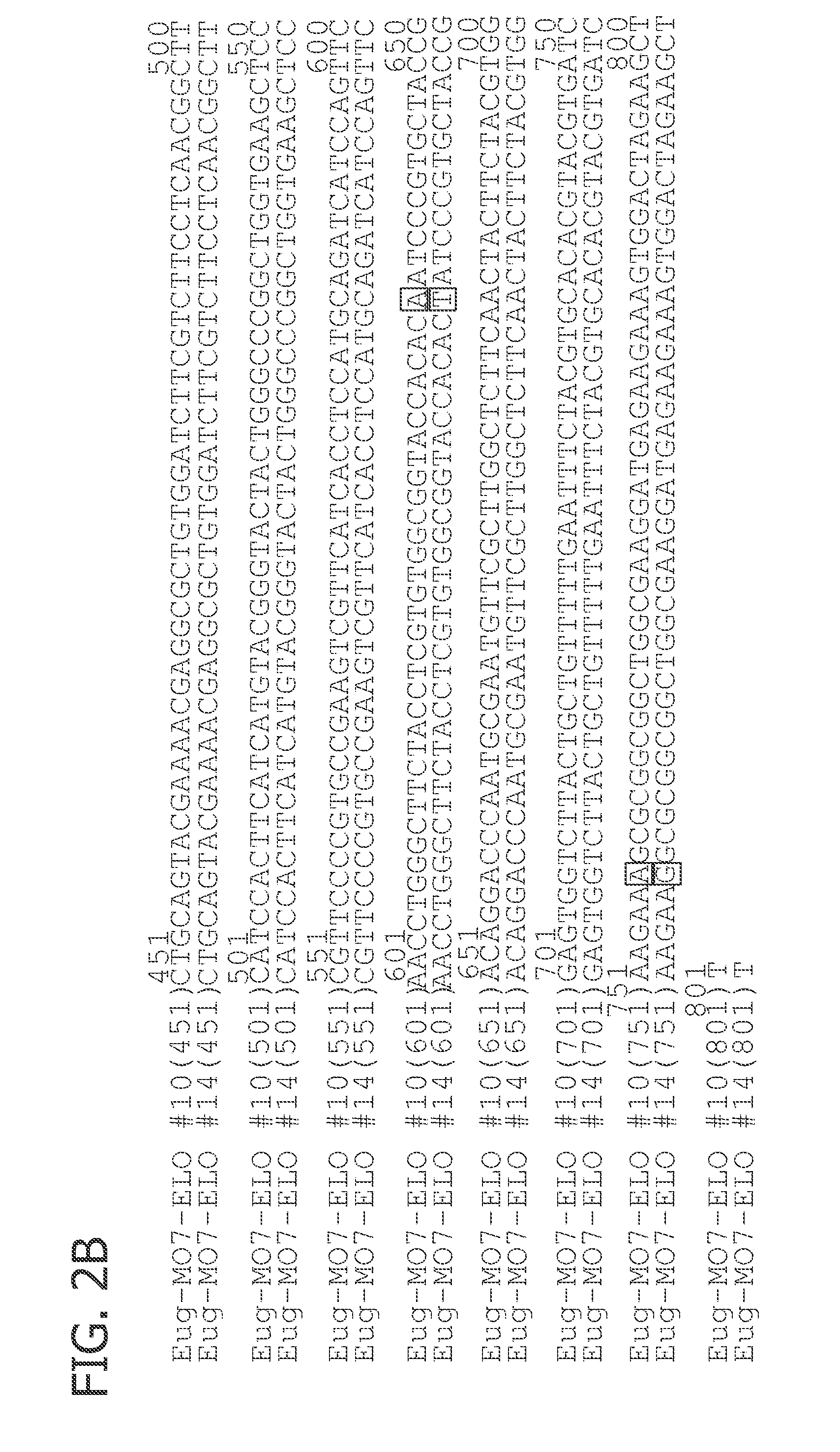Novel delta9-elongase for production of polyunsaturated fatty acid-enriched oils
a polyunsaturated fatty acid and delta9 technology, applied in the direction of enzymology, ligases, transferases, etc., can solve the problems of substrate-specific step and rate-limiting step
- Summary
- Abstract
- Description
- Claims
- Application Information
AI Technical Summary
Benefits of technology
Problems solved by technology
Method used
Image
Examples
example 1
cDNA Library Construction from Euglena deses Ehr. CCMP 2916 and Sequence Analysis to Isolate Putative 49 Elongase Candidates
[0171]Analysis of the fatty acid composition of some marine algae revealed the presence of a considerable amount of docosahexaenoic acid (DHA, 22:6 n-3) (15% by weight of total lipids) in Euglena deses Ehr. CCMP 2916 (see Table 1). In addition, this organism displayed intermediates of the alternate Δ8-desaturase / Δ9-elongase pathway (see FIG. 1), indicating that this pathway is active in this organism. Thus, it is predicted that this organism would contain an active Δ9-elongase capable of converting linoleic acid (LA, 18:2 n-6) to ω6-Eicosadienoic acid (ω6-EDA, 20:2 n-6), or α-linolenic acid (ALA, 18:3, n-3) to ω3-Eicosatrienoic acid (ω3-ETrA, 20:3n-3), as well as an active Δ8-desaturase that would convert ω6-Eicosadienoic acid (ω6-EDA, 20:2 n-6) to Dihomo-γ-linolenic acid (DGLA, 20:3 n-6), or ω3-Eicosatrienoic acid (ω3-EtrA, 20:3n-3) to ω3-Eicosatetraenoic acid...
example 2
Isolation of the 3′-end of the plate2 MO7 elongase from Euglena deses Ehr. CCMP 2916
[0178]The plate2_MO7 clone sequence from Example 1 was used as a template to isolate its 3′-end.
[0179]First strand cDNA was synthesized using the SMART™ RACE kit (BD Biosciences) according to the manufacturer's instructions. For synthesis of 3′ RACE-ready cDNA, 1.5 μg total RNA from Euglena deses Ehr. CCMP 2916 and 1 μl of 3′ CDS primer (5′-AAGCAGTGGTATCAACGCAGAGTAC(T)30VN-3′, wherein N=A, C, G, or T; and V=A, G, or C (SEQ ID NO: 8)) (12 μM) were mixed in a total volume of 5 μl in a nuclease-free PCR tube, incubated at 70° C. for 2 minutes, and snap-chilled on ice. After brief centrifugation, 2 μl of 5× first strand buffer [250 mM Tris-HCl (pH-8.3), 375 mM KCl and 30 mm MgCl2], 1 μl of 0.1 M DTT and 1 μl of 10 mM dNTP mix was added to the tubes. After incubation at 42° C. for 2 minutes, 1 μl of reverse transcriptase (PowerScript™ RT, BD Biosciences) was added to the tube and incubated at 42° C. for 9...
example 3
Isolation of the Full-Length plate2 M07 Elongase Gene from Euglena deses Ehr. CCMP 2916
[0184]The full-length gene sequence of plate2_MO7 elongase was isolated by PCR amplification using the Euglena deses Ehr. cDNA library as the template, and primers that were designed to contain the 5′- and 3′-ends of the plate2_M07 gene based upon sequence information obtained in Example 1 and Example 2. In addition, BamHI / HindIII sites were incorporated into the primers (underlined) to facilitate cloning of the gene into the BamHI / HindIII sites of the yeast expression vector, pYX242. The following primer sequences were used:
M07-Elo forward primer:(SEQ ID NO: 15)5′-CAC CAT GGA TCC ATG GAC GTC GCG ACT ACG CTGG-3′,andM07-Elo reverse primer:(SEQ ID NO: 16)5′-ACG CGT AAG CTT CTA GTC CAC TTT CTT CTC ATCCTT C-3′.
[0185]Amplification was carried out using 0.5 μl (100 μM) of each primer, 1 μl (˜110 ng) of the Euglena deses Ehr. cDNA library plasmid pool as the template, 5 μl of 2.5 mM dNTP, 10 μl of 5× Phu...
PUM
| Property | Measurement | Unit |
|---|---|---|
| temperature | aaaaa | aaaaa |
| temperature | aaaaa | aaaaa |
| pH | aaaaa | aaaaa |
Abstract
Description
Claims
Application Information
 Login to View More
Login to View More - R&D
- Intellectual Property
- Life Sciences
- Materials
- Tech Scout
- Unparalleled Data Quality
- Higher Quality Content
- 60% Fewer Hallucinations
Browse by: Latest US Patents, China's latest patents, Technical Efficacy Thesaurus, Application Domain, Technology Topic, Popular Technical Reports.
© 2025 PatSnap. All rights reserved.Legal|Privacy policy|Modern Slavery Act Transparency Statement|Sitemap|About US| Contact US: help@patsnap.com



